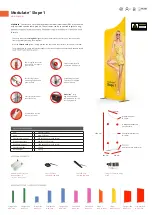
22
85812
THE FOLLOWING SERVICE AND
ADJUSTMENT PROCEDURES ARE
FOR QUALIFIED SERVICE LEVEL
PERSONNEL ONLY.
TO AVOID SERIOUS INJURY,
Do Not Attempt To Service any Part of the
WideSpin 1530 TM Top Dresser When It Is
Operating.
TO AVOID SERIOUS INJURY,
Always Follow All Safety Hazard Warnings.
Work Safely And Wear The Appropriate Safety
Gear When Servicing The WideSpin 1530 TM.
Properly Secure The WideSpin 1530 TM Top
Dresser Before Starting Any Adjustment, Service
or Lubrication Procedures.
LUBRICATION
All the bearings on the WideSpin 1530 TM Top
Dresser are sealed and require no further lubrication.
Periodically inspect the bearings on the front and
rear conveyor belt rollers and the spinner wheels for
wear, damage, or a build up of dirt or debris. Clean
as required. The tilting swivel points on the spinner
assembly should be periodically cleaned, inspected
for wear or damage, and lightly coated with machine
oil for rust and moisture protection.
INSPECTION PANEL
Access to view the inside surface of the conveyor belt
can be gained by removing the inspection panel. The
inspection panel is located on the right side of the
frame. The inspection panel can also be used to aid in
the cleaning of the top of the dirt shield.
CONVEYOR BELT CARE
The conveyor belt is a PVC composition belt with a
splice. Check the condition of the belt surface, look
for wear, cuts, and deep scrapes. Check the splice,
the splice wire should be in good condition. The splice
should not be catching on the hopper seals or the
metering gate. Replacement of the conveyor belts may
be necessary if it has been damaged, is worn, or will
no longer stay in proper alignment or adjustment.
Top dressing material can pass through the splice
causing a build-up of top dressing material on the inside
of the conveyor belt, on the conveyor pan and on the
rollers. Inspect and clean any buildup of top dressing
material from the inside surfaces of the conveyor belt.
To prolong the life of the conveyor belt, store the
WideSpin 1530 TM with the hopper empty, belt
cleaned, and out of direct sunlight.
Service Level Maintenance
CONVEYOR BELT SCRAPER
The scraper should lightly rub on the belt. The scraper
should be adjusted to maintain the light contact. Check
for a buildup of top dressing material in and around
the springs that may restrict the contact. If the plastic
conveyor belt scraper is worn and no longer touches
the belt, the plastic blade should be replaced to restore
contact with the belt.
CONVEYOR BELT TENSION ADJUSTMENTS
(See Figure 8)
The tension on the conveyor belt must be adequate
to assure that the conveyor belt moves at the same
rate as the rear drive roller. After extended use, top
dressing material may build up on the front and rear
rollers causing undue tension on the conveyor belt or
off-center tracking problems. Clean the rollers before
adjusting the conveyor belt tension.
Conveyor belt tension is adjustable by tightening or
loosening the conveyor belt adjusters. The adjusters
are located on both sides of the frame near the front
of the hopper.
Before adjusting the conveyor belt for tension or
tracking problems, check the following:
● Check for a buildup of top dressing material on the
inside of the conveyor belts.
● Check for a buildup of top dressing material on the
surfaces of the idler and drive conveyor belt rollers.
● Look for damaged, worn or loose bearings on the
idler and drive conveyor belt rollers.
● Look for broken or damaged conveyor belt tension
adjusters.
Initial adjustment is measured at the ends of the
adjuster screws. The initial setting should be 25 mm
(1” inch).
If the belt still slips under load, tighten conveyor belt
adjusting screws equally at 1/2 turn intervals until
slippage stops. If belt still does not operate properly,
reset the screws to 25 mm (1” inch) and check for
problems elsewhere.
WARNING
25 mm (1" INCH)
FIGURE 8
SV85811-01
SERVICE LEVEL MAINTENANCE
















































